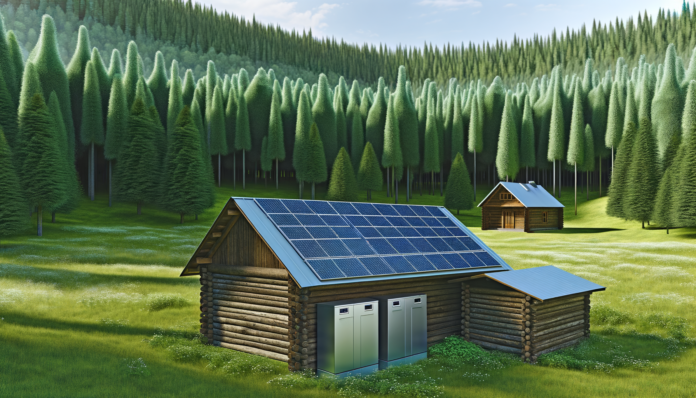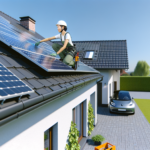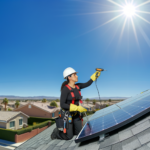Introduction to Off-Grid Living and Solar Power
The Appeal of Off-Grid Living
Off-grid living has surged in popularity as more people seek to escape the hustle and bustle of urban life. The allure of self-sufficiency, reduced environmental impact, and the opportunity to reconnect with nature are compelling reasons for this lifestyle choice. Whether it’s a remote cabin in the woods, a tiny house on wheels, or a secluded beach hut, off-grid living offers a unique sense of freedom and independence. The idea of being untethered from traditional utilities and living sustainably resonates with many who yearn for a simpler, more intentional way of life.
Benefits of Solar Power for Outdoor Escapes
Solar power is a game-changer for those looking to live off the grid. Here are some key benefits:
- Renewable Energy Source: Solar power harnesses energy from the sun, a renewable and inexhaustible resource.
- Cost Savings: After the initial setup costs, solar power systems can significantly reduce or even eliminate electricity bills.
- Low Maintenance: Solar power systems require minimal maintenance, making them ideal for remote locations.
- Environmental Impact: Solar energy is clean and produces no greenhouse gas emissions, reducing your carbon footprint.
- Energy Independence: With a solar power system, you are less reliant on external power sources, providing greater energy security.
Overview of Solar Power Systems
A solar power system is composed of several key components that work together to convert sunlight into usable electricity. Here’s a brief overview:
- Solar Panels: These are the most visible part of the system and are responsible for capturing sunlight and converting it into direct current (DC) electricity. There are three main types of solar panels: Monocrystalline, Polycrystalline, and Thin Film, each with its own efficiency and cost characteristics.
- Charge Controller: This device regulates the voltage and current coming from the solar panels to the batteries, preventing overcharging and prolonging battery life.
- Batteries: Batteries store the electricity generated by the solar panels for use when the sun isn’t shining. Common types include Sealed Lead Acid (SLA) and Gel batteries, typically available in 12V and 24V configurations.
- Inverter: The inverter converts the DC electricity stored in the batteries into alternating current (AC) electricity, which is used by most household appliances.
By understanding these components and their functions, you can better appreciate how a solar power system can support your off-grid lifestyle. In the following sections, we will delve deeper into each aspect, guiding you through the process of planning, building, and maintaining your own solar power system for your outdoor escapes.
Understanding Solar Power Basics
How Solar Panels Work
Solar panels, also known as photovoltaic (PV) panels, convert sunlight into electricity. They are composed of many solar cells made from semiconductor materials, typically silicon. When sunlight hits these cells, it excites electrons, creating an electric current. This process is known as the photovoltaic effect. The generated direct current (DC) electricity is then converted into alternating current (AC) electricity, which is used to power most household appliances.
Types of Solar Panels
There are three main types of solar panels, each with its own advantages and disadvantages:
- Monocrystalline Solar Panels: These panels are made from a single crystal structure, making them the most efficient type, with efficiency rates ranging from 17% to 22%. They are also the most expensive due to their complex manufacturing process. Monocrystalline panels are ideal for those who have limited space but want maximum efficiency.
- Polycrystalline Solar Panels: These are made from multiple silicon crystals, making them slightly less efficient, with rates between 15% and 17%. However, they are more affordable and are commonly used in residential installations. Polycrystalline panels are a good choice for those on a budget.
- Thin-Film Solar Panels: These panels are made by depositing a thin layer of photovoltaic material onto a substrate like glass or metal. They are the least efficient, with rates around 10% to 13%, but they are also the cheapest and can be flexible. Thin-film panels are often used in large-scale industrial applications.
Key Components of a Solar Power System
A solar power system is more than just solar panels. It includes several key components that work together to generate, store, and distribute electricity:
- Solar Panels: These capture sunlight and convert it into DC electricity.
- Charge Controller: This device regulates the voltage and current coming from the solar panels to the batteries, preventing overcharging and prolonging battery life.
- Batteries: These store the electricity generated by the solar panels for use when sunlight is not available. There are different types of batteries, including flooded lead-acid, AGM, nickel-iron, and lithium-ion, each with its own pros and cons.
- Inverter: This converts the DC electricity stored in the batteries into AC electricity, which is used by most household appliances.
- Mounting System: This includes the racks and hardware used to mount the solar panels on your roof or on the ground.
- Wiring and Electrical Components: These include all the cables, connectors, and fuses needed to connect the system components and ensure safe operation.
Understanding these basics will help you make informed decisions as you plan and build your solar power system for off-grid living.
Planning Your Solar Power System
Assessing Your Power Needs
Before diving into the technical aspects of building a solar power system, it’s crucial to assess your power needs. This step involves understanding how much energy you will require for your off-grid living. Start by listing all the electrical devices and appliances you plan to use, such as lights, refrigerators, water pumps, and electronic gadgets.
For each item, note its wattage and estimate the number of hours you will use it daily. Multiply the wattage by the hours of use to get the daily watt-hour (Wh) consumption for each device. Sum up the Wh for all devices to get your total daily energy requirement.
For example:
– LED Light: 10W x 5 hours = 50Wh
– Refrigerator: 100W x 24 hours = 2400Wh
– Laptop: 50W x 4 hours = 200Wh
Total daily energy requirement = 50Wh + 2400Wh + 200Wh = 2650Wh
Add a buffer of 20-30% to account for inefficiencies and unexpected usage, bringing the total to approximately 3445Wh. This figure will guide you in selecting the appropriate size for your solar power system.
Choosing the Right Location
The location of your solar panels is critical for maximizing energy production. Ideally, you want a spot that receives ample sunlight throughout the day, free from obstructions like trees, buildings, or hills.
**Key considerations for choosing the right location:**
– **Sunlight Exposure:** Ensure the site gets at least 5-6 hours of direct sunlight daily.
– **Orientation and Tilt:** In the Northern Hemisphere, panels should face south to capture the most sunlight. The tilt angle should be equal to your latitude for optimal performance.
– **Future Obstructions:** Consider the growth of nearby trees or potential construction that could cast shadows on your panels in the future.
– **Accessibility:** Make sure the panels are easily accessible for cleaning and maintenance.
If roof space is limited or shaded, consider ground-mounted systems. These can be placed in open areas and adjusted for optimal sun exposure.
Sizing Your Solar Power System
Once you have assessed your power needs and chosen the right location, the next step is to size your solar power system. This involves determining the number of solar panels, batteries, and other components required to meet your energy demands.
**Steps to size your system:**
1. **Calculate Total Daily Energy Requirement:** As previously calculated, let’s assume your total daily energy requirement is 3445Wh.
2. **Determine Solar Panel Output:** Solar panels are rated by their peak wattage (W). For instance, a 300W panel produces 300W of power under ideal conditions. However, actual output varies based on sunlight hours and panel efficiency. Assume an average of 5 peak sunlight hours per day.
Daily energy production per panel = 300W x 5 hours = 1500Wh
3. **Number of Panels Needed:** Divide your total daily energy requirement by the daily energy production per panel.
Number of panels = 3445Wh / 1500Wh ≈ 2.3
Round up to ensure you meet your energy needs, so you would need 3 panels.
4. **Battery Storage:** To store the energy generated, you’ll need batteries. Calculate the total storage capacity required by multiplying your daily energy requirement by the number of days you want to store energy (usually 1-3 days for off-grid systems).
Total storage capacity = 3445Wh x 2 days = 6890Wh
If using 12V batteries, convert Wh to amp-hours (Ah):
Total storage capacity in Ah = 6890Wh / 12V ≈ 574Ah
Choose batteries that can handle this capacity, considering the depth of discharge (DoD) to prolong battery life. For example, if using batteries with a 50% DoD, you would need double the capacity, or approximately 1148Ah.
5. **Other Components:** Ensure you have a charge controller to prevent battery overcharging, an inverter to convert DC to AC if needed, and appropriate wiring and safety equipment.
By carefully planning and sizing your solar power system, you can ensure a reliable and efficient energy source for your off-grid living.
Building Your Solar Power System
Selecting Solar Panels
Choosing the right solar panels is crucial for the efficiency and effectiveness of your off-grid solar power system. There are three main types of solar panels to consider: **Monocrystalline**, **Polycrystalline**, and **Thin Film**.
- Monocrystalline: These panels are made from a single crystal of silicon, making them the most efficient option, with efficiency rates ranging from 17% to 22%. They are also the most expensive but offer a sleek aesthetic and better performance in low-light conditions.
- Polycrystalline: Made from multiple silicon sources, these panels are slightly less efficient, with rates between 15% and 17%. They are more affordable and are commonly used in residential installations.
- Thin Film: These panels are created by depositing a thin layer of photovoltaic material onto a surface like glass. They are less efficient (10%-13%) but can perform better in low-light conditions. They are typically used in large-scale installations.
For most off-grid applications, **monocrystalline panels** are recommended due to their higher efficiency and durability, despite the higher cost.
Choosing a Charge Controller
A charge controller is essential for regulating the voltage and current coming from your solar panels to your batteries. It prevents overcharging and extends the life of your batteries. There are two main types of charge controllers:
- PWM (Pulse Width Modulation): These are simpler and less expensive but less efficient. They are suitable for smaller systems with lower power requirements.
- MPPT (Maximum Power Point Tracking): These are more efficient and can extract more power from your solar panels, especially in varying weather conditions. They are ideal for larger systems where efficiency is crucial.
For most off-grid systems, an **MPPT charge controller** is recommended due to its higher efficiency and better performance.
Picking the Right Batteries
Batteries store the energy generated by your solar panels for use when the sun isn’t shining. The type of battery you choose will affect the overall performance and lifespan of your system. Common types include:
- Flooded Lead-Acid: These are the most affordable but require regular maintenance and ventilation.
- AGM (Absorbent Glass Mat): These are maintenance-free and have a longer lifespan than flooded lead-acid batteries but are more expensive.
- Gel: These are also maintenance-free and perform well in extreme temperatures but are more expensive and less efficient than AGM batteries.
- Lithium-Ion: These are the most efficient, longest-lasting, and require no maintenance. They are, however, the most expensive option.
For most off-grid systems, **lithium-ion batteries** are recommended due to their efficiency, longevity, and low maintenance requirements.
Inverters and Their Importance
An inverter converts the DC (direct current) electricity generated by your solar panels and stored in your batteries into AC (alternating current) electricity, which is used by most household appliances. There are three main types of inverters:
- Pure Sine Wave Inverters: These provide a smooth and consistent wave of electricity, making them suitable for sensitive electronics and appliances. They are the most expensive but offer the best performance.
- Modified Sine Wave Inverters: These are less expensive but produce a choppier wave of electricity, which can be less efficient and potentially harmful to some electronics.
- Square Wave Inverters: These are the least expensive and least efficient, suitable only for simple devices like lights and heaters.
For most off-grid systems, a **pure sine wave inverter** is recommended due to its efficiency and compatibility with a wide range of appliances.
By carefully selecting each component of your solar power system, you can ensure that your off-grid living experience is both efficient and sustainable.
Installation and Setup
Mounting Solar Panels
Mounting your solar panels correctly is crucial for maximizing their efficiency and ensuring their longevity. Here are the steps to follow:
1. **Choose the Right Mounting System**: Depending on your location and the structure of your off-grid setup, you can opt for roof-mounted or ground-mounted systems. Roof-mounted systems are ideal for cabins with ample sunlight exposure and a suitable roof pitch. Ground-mounted systems offer flexibility in positioning and are easier to maintain.
2. **Determine the Optimal Angle and Direction**: Solar panels should ideally face south in the Northern Hemisphere to capture the maximum amount of sunlight. The angle of the panels should be adjusted according to your latitude to optimize solar energy absorption throughout the year.
3. **Install the Mounting Hardware**: Secure the mounting brackets to your roof or ground structure. Ensure that the brackets are firmly attached to withstand wind and other environmental factors. For roof installations, it’s essential to locate and secure the brackets to the rafters for added stability.
4. **Attach the Solar Panels**: Once the mounting hardware is in place, carefully attach the solar panels to the brackets. Use the appropriate bolts and clamps to secure the panels, ensuring they are tightly fastened to prevent any movement.
Connecting Components
After mounting the solar panels, the next step is to connect all the components of your solar power system. This includes the charge controller, batteries, and inverter.
1. **Wiring the Solar Panels**: Connect the solar panels in series or parallel, depending on your system’s voltage requirements. Series connections increase the voltage, while parallel connections increase the current. Use appropriate solar cables and connectors to ensure a secure and efficient connection.
2. **Connecting to the Charge Controller**: The charge controller regulates the voltage and current coming from the solar panels to the batteries. Connect the positive and negative wires from the solar panels to the corresponding terminals on the charge controller. Ensure that the connections are tight and secure.
3. **Battery Bank Setup**: Connect the charge controller to the battery bank. Use thick, high-quality cables to minimize resistance and energy loss. Ensure that the batteries are connected in a configuration that matches your system’s voltage requirements (e.g., series for higher voltage, parallel for higher capacity).
4. **Inverter Connection**: If your appliances require AC power, connect the inverter to the battery bank. The inverter converts the DC power stored in the batteries to AC power. Ensure that the inverter is properly grounded and that all connections are secure.
Safety Considerations
Safety is paramount when installing and setting up a solar power system. Here are some key safety tips to keep in mind:
1. **Electrical Safety**: Always work with the system powered down to avoid electrical shocks. Use insulated tools and wear rubber-soled shoes to minimize the risk of electric shock. Double-check all connections before powering up the system.
2. **Proper Grounding**: Ensure that all components, including the solar panels, charge controller, batteries, and inverter, are properly grounded. This helps prevent electrical faults and protects against lightning strikes.
3. **Fire Safety**: Use fire-resistant materials for mounting and wiring. Ensure that all electrical connections are secure and free from corrosion to prevent overheating and potential fire hazards.
4. **Structural Safety**: Ensure that the mounting system is securely attached to the roof or ground structure. Regularly inspect the mounting hardware for signs of wear or damage and make necessary repairs promptly.
5. **Battery Safety**: Handle batteries with care, as they contain hazardous chemicals. Wear protective gear, such as gloves and safety glasses, when working with batteries. Ensure that the battery bank is well-ventilated to prevent the buildup of explosive gases.
By following these steps and safety considerations, you can successfully install and set up your solar power system, ensuring a reliable and efficient source of energy for your off-grid living.
Maintenance and Troubleshooting
Routine Maintenance Tips
Maintaining your solar power system is crucial to ensure its longevity and efficiency. Here are some routine maintenance tips to keep your system running smoothly:
- Regular Cleaning: Dust, dirt, and debris can accumulate on solar panels, reducing their efficiency. Clean the panels with water and a soft brush or cloth every few months, or more frequently if you live in a dusty area.
- Inspect Connections: Periodically check all electrical connections, including wiring and terminals, for signs of corrosion or wear. Tighten any loose connections to prevent power loss and potential hazards.
- Monitor Performance: Keep an eye on your system’s performance through monitoring software or a charge controller display. Look for any significant drops in power output, which could indicate an issue.
- Battery Maintenance: For lead-acid batteries, check the electrolyte levels and top up with distilled water if necessary. Ensure that battery terminals are clean and free from corrosion.
- Check for Shading: Ensure that no new obstructions, such as growing trees or new structures, are casting shadows on your panels. Even partial shading can significantly reduce efficiency.
Common Issues and Solutions
Even with regular maintenance, you may encounter some common issues with your solar power system. Here are a few problems and their solutions:
- Low Power Output: If your system is producing less power than expected, check for dirty panels, shading, or faulty connections. Clean the panels, remove any obstructions, and inspect the wiring.
- Battery Not Charging: If your batteries are not charging, the issue could be with the charge controller, wiring, or the batteries themselves. Check the charge controller settings and connections. If the problem persists, test the batteries and replace them if necessary.
- Inverter Issues: If your inverter is not functioning correctly, it could be due to improper installation, overheating, or a faulty unit. Ensure the inverter is installed in a well-ventilated area and check all connections. If the problem continues, consult the manufacturer’s troubleshooting guide or contact customer support.
- Overheating Components: Overheating can reduce the efficiency and lifespan of your system. Ensure that all components, especially the inverter and batteries, are installed in well-ventilated areas. Consider adding fans or heat sinks if overheating persists.
Upgrading Your System
As your power needs grow or as technology advances, you may find it necessary to upgrade your solar power system. Here are some tips for upgrading:
- Increase Panel Capacity: If you need more power, consider adding more solar panels to your array. Ensure that your charge controller and inverter can handle the increased capacity.
- Upgrade Batteries: Switching to higher-capacity or more efficient batteries, such as lithium-ion, can improve your system’s performance and storage capacity. Ensure compatibility with your existing charge controller and inverter.
- Advanced Monitoring Systems: Upgrading to a more sophisticated monitoring system can provide better insights into your system’s performance and help you identify issues more quickly.
- Integrate Other Renewable Sources: Consider integrating other renewable energy sources, such as wind or hydro power, to complement your solar system and provide a more stable power supply.
By following these maintenance tips, addressing common issues promptly, and considering strategic upgrades, you can ensure that your solar power system remains efficient and reliable for your off-grid living needs.
Maximizing Efficiency and Sustainability
Energy-Saving Tips
Maximizing the efficiency of your solar power system is crucial for sustainable off-grid living. Here are some energy-saving tips to help you get the most out of your setup:
- Use Energy-Efficient Appliances: Opt for appliances that are designed to consume less power. Look for Energy Star-rated products, which are certified to be more energy-efficient.
- LED Lighting: Replace traditional incandescent bulbs with LED lights. LEDs use significantly less energy and have a longer lifespan.
- Smart Usage: Be mindful of your energy consumption. Turn off lights and unplug devices when not in use. Use power strips to easily disconnect multiple devices at once.
- Insulation: Properly insulate your cabin to reduce the need for heating and cooling. This can significantly lower your energy consumption.
- Solar Water Heating: Use solar water heaters to reduce the energy required for heating water. These systems can be highly efficient and cost-effective.
Integrating Other Renewable Energy Sources
While solar power is a fantastic primary energy source, integrating other renewable energy sources can further enhance your system’s efficiency and reliability.
- Wind Power: If your location is windy, consider installing a wind turbine. Wind power can complement solar energy, especially during cloudy or nighttime conditions.
- Hydropower: If you have access to a flowing water source, micro-hydropower systems can provide a consistent and reliable energy supply.
- Biomass: Biomass energy, derived from organic materials like wood and agricultural waste, can be a sustainable way to generate heat and electricity.
- Hybrid Systems: Combining multiple renewable energy sources into a hybrid system can ensure a more stable and continuous power supply, reducing reliance on any single source.
Future Trends in Solar Technology
The field of solar technology is rapidly evolving, with new advancements promising to make solar power even more efficient and accessible.
- Perovskite Solar Cells: These next-generation solar cells offer higher efficiency and lower production costs compared to traditional silicon-based cells. They are flexible and can be integrated into various surfaces.
- Bifacial Solar Panels: These panels can capture sunlight from both sides, increasing their energy output. They are particularly effective in snowy or reflective environments.
- Solar Roof Tiles: Solar roof tiles integrate seamlessly into the architecture of a building, providing an aesthetically pleasing alternative to traditional solar panels.
- Energy Storage Innovations: Advances in battery technology, such as solid-state batteries, promise higher energy density, faster charging, and longer lifespans, making energy storage more efficient.
- Smart Solar Systems: Integration of AI and IoT in solar systems allows for real-time monitoring and optimization, ensuring maximum efficiency and quick identification of issues.
By implementing these energy-saving tips, integrating other renewable energy sources, and staying informed about future trends in solar technology, you can maximize the efficiency and sustainability of your off-grid solar power system. This not only enhances your energy independence but also contributes to a more sustainable and eco-friendly lifestyle.






